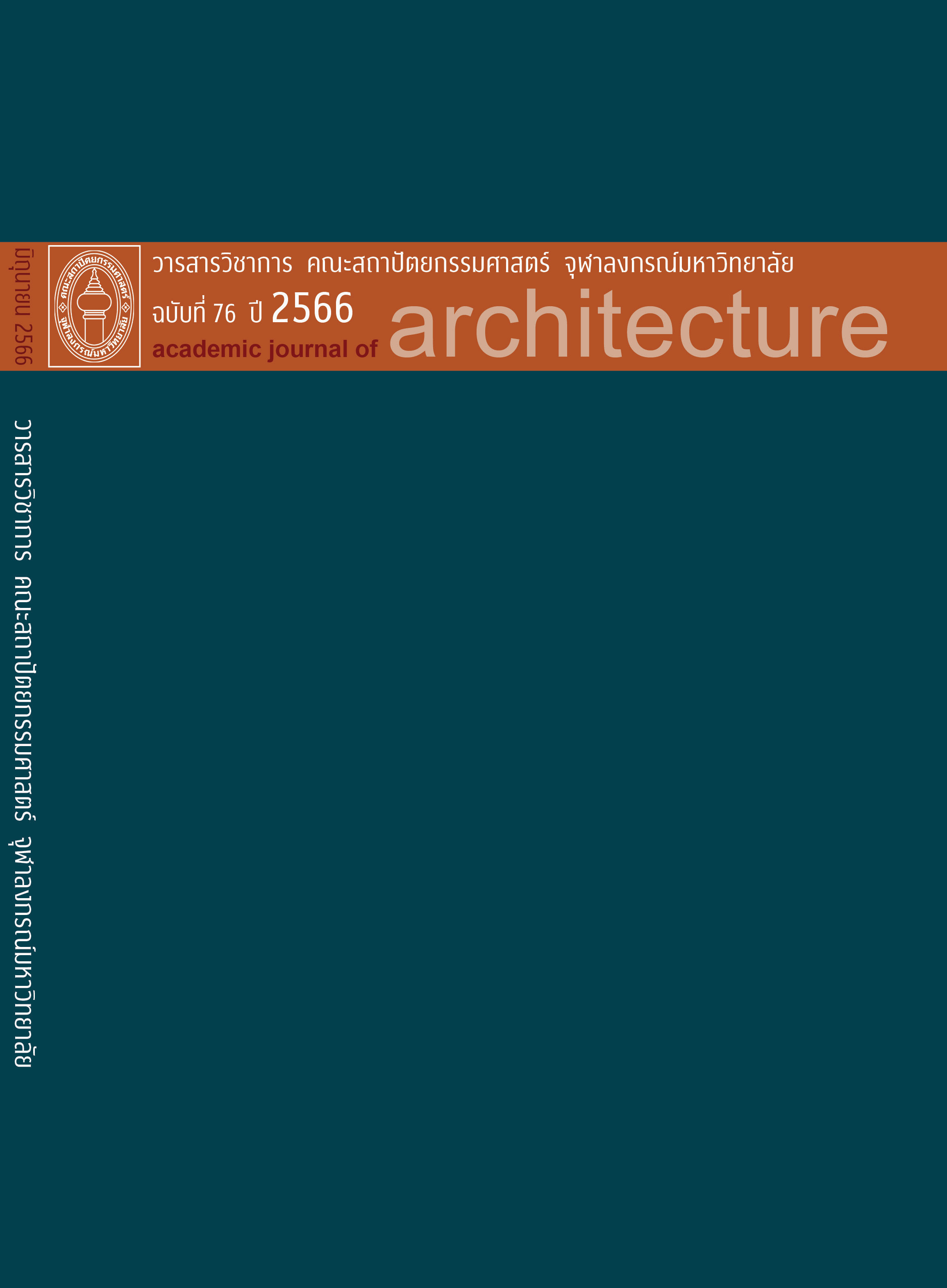A Review of Importance and Analysis Method of Stakeholder Collaboration for Festival Management as an Urban Strategy
Main Article Content
Abstract
Festival as a cultural activity could lead to the building of a creative community that is necessary for the formation of a cultural capital and the success of a creative city. In order to develop a festival that could create a positive impact on locals, the collaboration of stakeholders from all sectors is significant in determining the format of the festival that is suitable for the development goals and identity of the city. In addition, social network analysis could help to understand festival stakeholders within the network, as well as their roles and relationships, and to provide guidelines that are appropriate to further use festivals as an urban strategy. Currently, in Thailand, there is the term Festival Economy, which is an idea to drive the economy through the festivals, established to be a tool to attract tourists and develop the economy of the city through the festival. Thus, this paper aims to gather ideas, theories, and mechanisms that could lead to a collaboration of stakeholders to use festivals as an urban strategy and provide guidelines regarding forms of the collaborative development process that are suitable for Thailand.
Article Details
References
Adongo, Raymond. (2017). Social exchange, collaboration, and networking between stakeholders in traditional festivals. https://theses.lib.polyu.edu.hk/handle/200/9181
Adongo, Raymond, & Kim, Seongseop. (2018). The ties that bind: Stakeholder collaboration and networking in local festivals. International Journal of Contemporary Hospitality Management, 30(6), 2458–80. https://doi.org/10.1108/ijchm-02-2017-0112
Andersson, Tommy D., & Getz, Donald. (2008). Stakeholder management strategies of festivals. Journal of Convention & Event Tourism, 9(3), 199–220. https://doi.org/10.1080/15470140802323801
Bangkok Design Week. (2023). About. https://www.bangkokdesignweek.com/en/bkkdw2023/about
British Council Indonesia. (2022). Festivals in Southeast Asia report: Catalysts for the creative economy. British Council Indonesia. https://www.britishcouncil.my/festivals-south-east-asia-report-catalysts-creative-economy
CEA. (n.d.). Soft power, an important tool in driving Thai creative economy. CEA.https://www.cea.or.th/th/single-statistic/cea-soft-power
Chiang Mai blooms. (n.d.). [Powerpoint]. N.p.
Cudny, Waldemar. (2014). The phenomenon of festivals: Their origins, evolution, and classifications. Anthropos, 109(2), 640–56. https://doi.org/10.5771/0257-9774-2014-2-640
Ebers, Mark. (2015). Interorganizational relationships and networks. International Encyclopedia of the Social & Behavioral Sciences,621–25. https://doi.org/10.1016/b978-0-08-097086-8.73125-4
Engblom, Susanna. (2010). A study on event management case: Tomatkarnevalen [Graduate thesis, Vaasa University of Applied Sciences]. https://core.ac.uk/display/38007942?utm_source=pdf&utm_medium=banner&utm_campaign=pdf-decoration-v1
Falassi, Alessandro. (n.d.). Festival: Definition and morphology. https://www.brown.edu/Departments/Joukowsky_Institute/courses/cityandfestival09/files/9722047.PDF
Freeman, Richard R. (1984). Strategic management: A stakeholder approach. http://ci.nii.ac.jp/ncid/BA2420894X
Galaskiewicz, Joseph, & Ebers, Mark. (1997, October 1). The formation of inter-organizational networks. Contemporary Sociology, 28(1), 55. https://doi.org/10.2307/2653866
Getz, Donald. (2002). Why festivals fail. Event Management, 7(4), 209–19. https://doi.org/10.3727/152599502108751604
Getz, Donald, & Andersson Tommy. (2010). Festival stakeholders: Exploring relationships and dependency through a four-country comparison. Journal of Hospitality & Tourism Research, 34(4), 531–56. https://doi.org/10.1177/1096348010370862
Getz, Donald, Andersson Tommy, & Larson, Mia. (2007). Festival stakeholder roles: Concepts and case studies. Event Management,10(2), 103–22. https://doi.org/10.3727/152599507780676689
Gray, Barbara. (1990, July 1). Collaborating: Finding common ground for multiparty problems. Academy of Management Review, 15(3), 545. https://doi.org/10.2307/258026
Home Office. (2016, January). Social network analysis: How to guide. GOV.UK. https://assets.publishing.service.gov.uk/government/uploads/system/uploads/attachment_data/file/491572/socnet_howto.pdf
Jamal, Tazim B., & Getz, Donald. (1995). Collaboration theory and community tourism planning. Annals of Tourism Research, 22(1), 186-204. https://doi.org/10.1016/0160-7383(94)00067-3
Jamal, Tazim, & Getz, Donald. (2000). 9 Community roundtables for tourism-related conflicts: The dialectics of consensus and process structures. In Multilingual Matters EBooks (pp. 159–82). https://doi.org/10.21832/9780585354224-011
Karlsen, Sidsel, & Nordström, Caroline Stenbacka. (2009). Festivals in the Barents region: Exploring festival‐stakeholder cooperation. Scandinavian Journal of Hospitality and Tourism, 9(2-3), 130–45. https://doi.org/10.1080/15022250903157447
Karpińska -Krakowiak, Małgorzata. (2009). Festivalization of the city: Contemporary examples. In Urban People. https://lidemesta.cuni.cz/LM-1037-version1.pdf
Lesley, Roberts, & Simpson, Fiona. (2000). 12 Developing partnership approaches to tourism in central and eastern Europe. In Multilingual matters EBooks (pp. 230–46). https://doi.org/10.21832/9780585354224-014
Négrier, Emmanuel. (2014). Festivalisation: Patterns and limits. Focus on Festivals. https://doi.org/10.23912/978-1-910158-15-9-2668
Presenza, Angelo, & Locca, Simone. (2012). The weight of stakeholders on festival management: The case of music festivals in Italy. PASOS: Revista de Turismo y Patrimonio Cultural, 10(2), 25–35. https://doi.org/10.25145/j.pasos.2012.10.024
Punnoi, N., Siangarom, S., & Tarachai, J. (2022). Festival design for local development. N.p.
Quinn, Bernadette. (2013a). Festival. In Key concepts in event management (pp. 47–51). Sage. https://doi.org/10.4135/9781473914742.n11
Quinn, Bernadette. (2013b). Stakeholders. In Key concepts in event management (pp. 140–43). Sagfe. https://doi.org/10.4135/9781473914742.n32
Soonsan, N. (2017, June). Stakeholder management for Tourism Businesses: The case of Thailand. Human Behavior, Development, and Society, 15. https://so01.tci-thaijo.org/index.php/hbds/article/view/180662
TCEB. (n.d.). Awakening Thailand to the world with the 'Festival Economy’. The Thailand Convention and Exhibition Bureau (TCEB). https://www.tceb.or.th/th/press-media/news-press-release/detail/1355-wake-thailand-up-to-be-world-famous-through-festival-economy
Teami School of New. (2021, October 13). Importance of collaboration in event management. https://www.teami.org/importance-of-collaboration-in-event-management/
UNCTAD. (2010, December 14). Creative economy report 2010. UNCTAD. https://unctad.org/publication/creative-economy-report-2010
Waayers, David, Lee, Diane, & Newsome, David. (2012). Exploring the nature of stakeholder collaboration: A case study of marine turtle tourism in the Ningaloo region, western Australia. Current Issues in Tourism, 15(7), 673–92. https://doi.org/10.1080/13683500.2011.631697
Watt, David S. (1998). Event management in leisure and tourism. http://ci.nii.ac.jp/ncid/BA41943483
Yaghmour, Samer, & Scott, Noel. (2009). Inter‐organizational collaboration characteristics and outcomes: A case study of the Jeddah festival. Journal of Policy Research in Tourism, Leisure and Events, 1(2), 115–30. https://doi.org/10.1080/19407960902992175
Yang, Song, Keller, Franziska B., & Zheng, Lu. (2017). Basics of social network analysis. In Social network analysis: Methods and examples (pp. 2–25). Sage. https://doi.org/10.4135/9781071802847.n1
Yilmaz, Burcu Selin, & Gunel, Ozgur Devrim. (2009). The importance of strategic stakeholder management in tourism sector: Research on probable applications. Tourismos: An International Multidisciplinary Journal of Tourism, 4, 97–108. https://www.researchgate.net/publication/47641734_The_importance_of_strategic_stakeholder_management_in_tourism_sector_Research_on_probable_applications
Zherdev, Nikolay. (2014). Festivalization as a creative city strategy. In IN3 working paper series. https://doi.org/10.7238/in3wps.v0i0.2151


